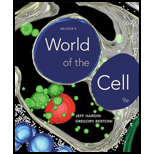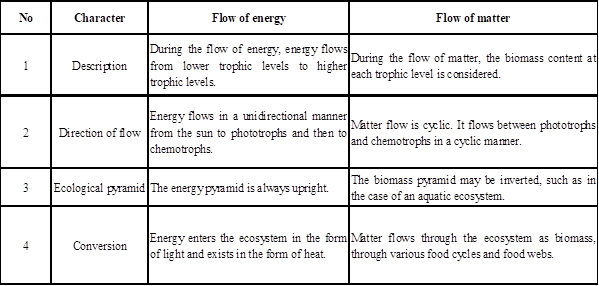
Concept explainers
How do phototrophs and chemotrophs depend intimately on each other? How does the flow of energy differ from the flow of matter?
To determine: How phototrophs and chemotrophs depend intimately on each other.
Introduction: All organisms derive their energy from the sunlight through direct or indirect methods. Phototrophs and chemotrophs are classified depending on the sources from which they derive their energy.
Explanation of Solution
Phototrophs are organisms which derive their energy directly from the sun. They have pigments that can absorb light. This light energy is converted to chemical energy and stored in the form of the energy currency of the cell that is ATP. Chemotrophs are organisms that derive their energy from the oxidation of electron donors in organic and inorganic molecules and use it for their processes. Following are the ways in which phototrophs and chemotrophs depend on each other:
- When light energy is not available, photoautotrophs need to act as chemotrophs so that they can continue to obtain energy.
- Even for the parts of the plant which are not exposed to the sunlight, their function as chemotrophs is necessary. Hence, most plants have both phototrophic as well as chemotrophic cells.
- Another way in which phototrophs depend on chemotrophs is that phototrophs need carbon sources other than carbon dioxide. They obtain these from chemotrophic organisms such as purple non-sulfur bacteria and green non-sulfur bacteria.
- Chemoheterotrophs are unable to produce their own food and thus they require food produced from phototrophs.
Thus, phototrophs and chemotrophs depend intimately on each other.
To determine: How the flow of energy differs from the flow of matter.
Introduction: All organisms derive their energy from the sunlight through direct or indirect methods. Phototrophs and chemotrophs are classified depending on the sources from which they derive their energy. The energy and mass flows through the ecosystem in a balanced way.
Explanation of Solution
The flow of energy differs from the flow of matter in following ways:

Phototrophs capture the light energy and convert it into chemical energy. This is them cycled throughout the system and gets converted into various forms. Photosynthesis and respiration are means by which energy flows through the different cycles. Finally, energy leaves a food chain in the form of heat. The organic matter produced by plants serves as the primary biomass for heterotrophs. This is how the flow of matter occurs in the ecosystem. The cycle is complete by decomposers, which convert organic biomass back into inorganic form.
Thus, the flow of energy and the flow of matter are interconnected and manage how mass and energy flows through different food cycles and trophic levels of the ecosystem.
Want to see more full solutions like this?
Chapter 5 Solutions
Becker's World of the Cell (9th Edition)
- Amino Acid Coclow TABle 3' Gly Phe Leu (G) (F) (L) 3- Val (V) Arg (R) Ser (S) Ala (A) Lys (K) CAG G Glu Asp (E) (D) Ser (S) CCCAGUCAGUCAGUCAG 0204 C U A G C Asn (N) G 4 A AGU C GU (5) AC C UGA A G5 C CUGACUGACUGACUGAC Thr (T) Met (M) lle £€ (1) U 4 G Tyr Σε (Y) U Cys (C) C A G Trp (W) 3' U C A Leu בוט His Pro (P) ££ (H) Gin (Q) Arg 흐름 (R) (L) Start Stop 8. Transcription and Translation Practice: (Video 10-1 and 10-2) A. Below is the sense strand of a DNA gene. Using the sense strand, create the antisense DNA strand and label the 5' and 3' ends. B. Use the antisense strand that you create in part A as a template to create the mRNA transcript of the gene and label the 5' and 3' ends. C. Translate the mRNA you produced in part B into the polypeptide sequence making sure to follow all the rules of translation. 5'-AGCATGACTAATAGTTGTTGAGCTGTC-3' (sense strand) 4arrow_forwardWhat is the structure and function of Eukaryotic cells, including their organelles? How are Eukaryotic cells different than Prokaryotic cells, in terms of evolution which form of the cell might have came first? How do Eukaryotic cells become malignant (cancerous)?arrow_forwardWhat are the roles of DNA and proteins inside of the cell? What are the building blocks or molecular components of the DNA and proteins? How are proteins produced within the cell? What connection is there between DNA, proteins, and the cell cycle? What is the relationship between DNA, proteins, and Cancer?arrow_forward
- please fill in the empty sports, thank you!arrow_forwardIn one paragraph show how atoms and they're structure are related to the structure of dna and proteins. Talk about what atoms are. what they're made of, why chemical bonding is important to DNA?arrow_forwardWhat are the structure and properties of atoms and chemical bonds (especially how they relate to DNA and proteins).arrow_forward
- The Sentinel Cell: Nature’s Answer to Cancer?arrow_forwardMolecular Biology Question You are working to characterize a novel protein in mice. Analysis shows that high levels of the primary transcript that codes for this protein are found in tissue from the brain, muscle, liver, and pancreas. However, an antibody that recognizes the C-terminal portion of the protein indicates that the protein is present in brain, muscle, and liver, but not in the pancreas. What is the most likely explanation for this result?arrow_forwardMolecular Biology Explain/discuss how “slow stop” and “quick/fast stop” mutants wereused to identify different protein involved in DNA replication in E. coli.arrow_forward
 Biology 2eBiologyISBN:9781947172517Author:Matthew Douglas, Jung Choi, Mary Ann ClarkPublisher:OpenStax
Biology 2eBiologyISBN:9781947172517Author:Matthew Douglas, Jung Choi, Mary Ann ClarkPublisher:OpenStax Biology Today and Tomorrow without Physiology (Mi...BiologyISBN:9781305117396Author:Cecie Starr, Christine Evers, Lisa StarrPublisher:Cengage Learning
Biology Today and Tomorrow without Physiology (Mi...BiologyISBN:9781305117396Author:Cecie Starr, Christine Evers, Lisa StarrPublisher:Cengage Learning Concepts of BiologyBiologyISBN:9781938168116Author:Samantha Fowler, Rebecca Roush, James WisePublisher:OpenStax College
Concepts of BiologyBiologyISBN:9781938168116Author:Samantha Fowler, Rebecca Roush, James WisePublisher:OpenStax College Principles Of Radiographic Imaging: An Art And A ...Health & NutritionISBN:9781337711067Author:Richard R. Carlton, Arlene M. Adler, Vesna BalacPublisher:Cengage Learning
Principles Of Radiographic Imaging: An Art And A ...Health & NutritionISBN:9781337711067Author:Richard R. Carlton, Arlene M. Adler, Vesna BalacPublisher:Cengage Learning Biology (MindTap Course List)BiologyISBN:9781337392938Author:Eldra Solomon, Charles Martin, Diana W. Martin, Linda R. BergPublisher:Cengage Learning
Biology (MindTap Course List)BiologyISBN:9781337392938Author:Eldra Solomon, Charles Martin, Diana W. Martin, Linda R. BergPublisher:Cengage Learning





